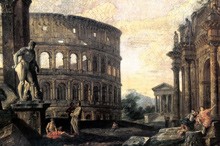
CLAS/HIST 330: The Roman Empire - Baths, Wine & Sex
Important Note: This course was formerly HSRE 330.
Course Description
How did average citizens of a town in the Roman Empire live? What were their daily habits, duties and pleasures? Where did they work, how was family life organized, and, finally, what was the system of beliefs and values that guided daily life? In order to answer such questions we will follow the life of ordinary citizens in Pompeii, an ordinary city on the shores of the Mediterranean in Roman Italy during the first century CE.
Famous for being destroyed by the eruption of Mt. Vesuvius in 79 CE and uniquely preserved under feet of hardened lava, Pompeii and the neighboring towns are now one of the most important archaeological sites in the world. Since their “rediscovery” in the 1700s, these cities have yielded tons of immensely valuable archaeological material: from remains of charred food to impressive ruins of public buildings; from written graffiti on the walls to rich art collections in individual houses. With all categories of material culture, Pompeii can provide us with an insight into social, political, religious, and commercial life in the ancient Roman world.
By tracing the footsteps of these people, we will explore the streets, homes, shops and public buildings of Pompeii and neighboring cities, such as Herculaneum. Through the things they left behind, we will learn about everyday life, and ultimately death, in the context of the ancient Roman world in general. Pompeii will serve as a microcosm for studying Roman society and culture. The overarching goal is to integrate archaeological, art historical, and primary literary material into a single, coherent intellectual narrative in order to gain a complex understanding of Roman Civilization at its height.
In the end, the goal is to “look at the Romans through the eyes of the Romans.”
Course Objectives
By the end of the course, students will be able to:
- list the major events in the history of ancient Rome;
- analyze both primary and secondary sources and to examine how authors of different time periods and social backgrounds present key issues;
- summarize the relevance of the use of material remains (archaeological record) in learning about Roman culture; and
- synthesize the various ways that Roman civilization influenced their culture, and, more generally, the development of world history in a coherent oral report.
Course Materials
PDFs of the readings are available on Umbra’s Moodle site. Additional hand-outs will be provided in classes when needed.
Lab Fee: $295.00 – Includes: three-days overnight trip to Pompeii, Naples and Herculaneum

